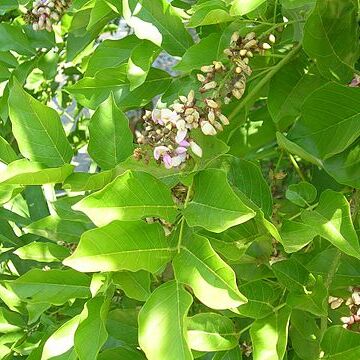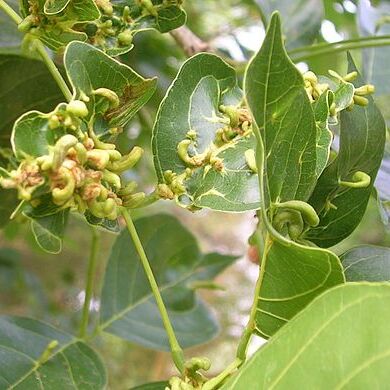Trees, shrubs, or lianas. Stipules present, persistent or caducous. Leaves imparipinnate; stipels present or absent; leaflet blades opposite or rarely subalternate. Inflorescence a pseudoraceme, unbranched (but branched in Millettia ichthyochtona), rachis with lateral flowering branchlets reduced to knobs or short spur at each node, flowers 2-5 in a clusters or fascicles per node; bracts and bracteoles present. Calyx tube broad, shortly 5-toothed; adaxial 2 teeth ± connate. Corolla standard large, with or without basal calluses. Vexillary stamen free in bud sometimes and becoming adherent to other 9 when mature. Ovary linear; style straight or inflexed. Legume 2-valved, flat, sometimes cylindric or inflated only around ellipsoid seeds, tardily dehiscent, not winged or with 2 wings perpendicular to abaxial or both sutures. Seeds 1 to several per legume, lenticular or globose; funicle fleshy, swelling at adaxial side, surrounding and clasping hilum as a short ringlike aril.
Tree. Leaves imparipinnate, with opposite leaflets; stipules caducous. Inflorescence axillary, raceme-like; flowers solitary or often in unstalked clusters of 2 at nodes of rachis; pedicels with a pair of minute bracteoles. Calyx cup-shaped, very weakly toothed. Petals pink and white; standard broadly obovate; keel cohering apically. Stamens with the upper stamen free at base but otherwise connate to staminal tube. Ovary hairy; ovules usually 2. Fruits oblong-elliptic, somewhat flattened, 2-valved; indehiscent or eventually dehiscent. Seeds 1 or 2.
Seeds usually well separated from one another, sometimes “longitudinal” (long axis parallel to that of pod), more often “transverse” or “obliquely transverse”, usually rather flat, usually having around the hilum a short ring-like white or yellow aril prolonged at one side into a strap-shaped process clasping the funicle.
Upper stamen usually free in the young bud and remaining so at its base in the mature flower, but usually becoming adherent to its neighbours above; 5 of the 9 united stamens rather longer than the others; anthers uniform, dorsifixed below the middle; filaments not widened at the tip.
Corolla rarely under 1 cm long, white, pink, blue or violet, not speckled, silky or glabrous outside; keel petals lightly united, somewhat pouched but not spurred, their claws and the usually rather longer claws of the wings often ± attached near the base to the filament sheath.
Ovary pubescent, sessile or shortly stipitate, with (2)3–11 ovules; style usually pubescent near the base, glabrous above, ± circular in cross-section, straight or incurved at the tip; stigma small, terminal, discoid or capitate.
Leaves imparipinnate, the leaflets entire, usually opposite; stipels usually present but absent in 2 cultivated species in the Flora area; a pulvinus present at the base of the peduncle.
Pod dehiscent, usually flat, rarely subcylindrical, 2-or more seeded; funicle often with a pulpy swelling at the proximal side (towards the pedicel).
Calyx almost truncate or divided for up to ? of its length, the upper pair of teeth united for most of their length.
Inflorescence paniculate, but often pseudoracemose by the contraction of the floriferous branches to mere knobs.
Disk between stamens and ovary tubular, annular or lobed or flat and undeveloped.
Trees, shrubs or lianes, or rarely semi-herbaceous plants with a woody rootstock.
Pending.


